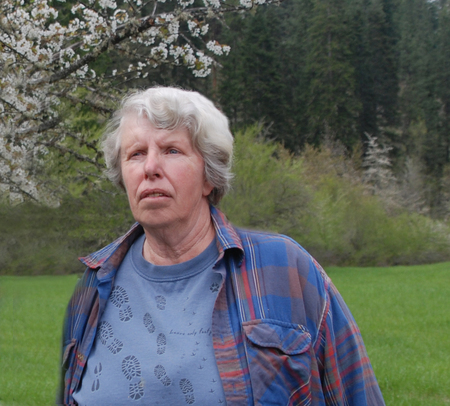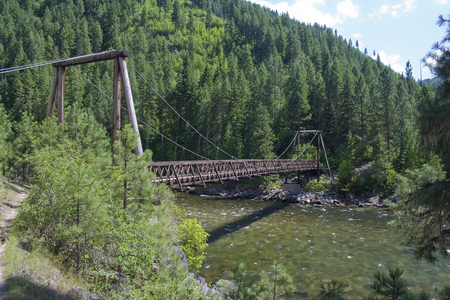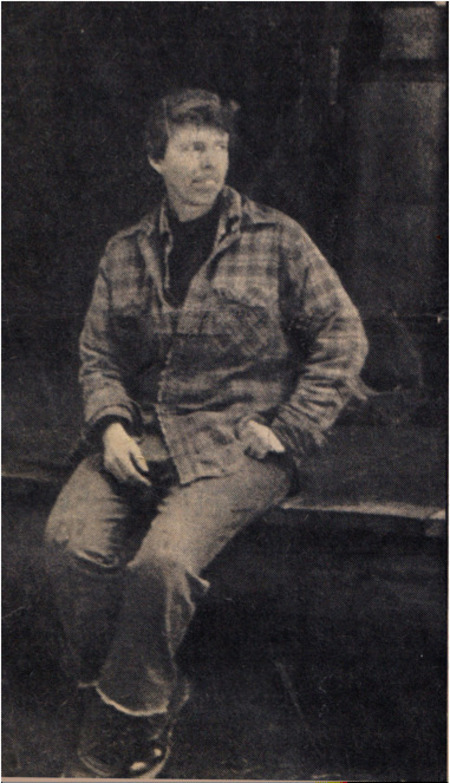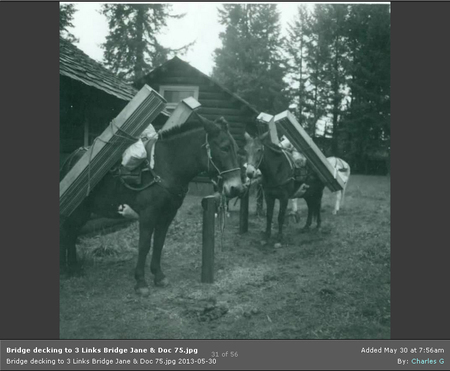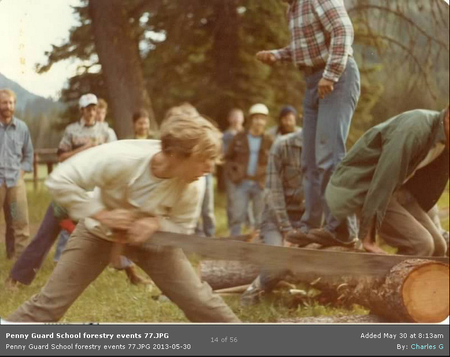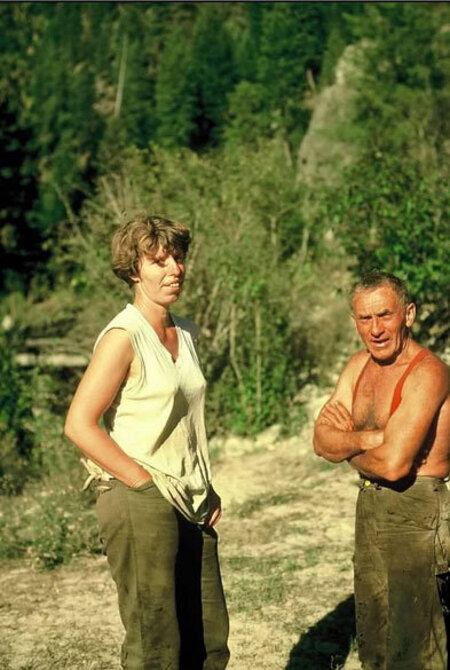Episode 18 : Backcountry Bridge Building : an interview with Penny Keck Item Info
In this episode, titled “Backcountry Bridge Building,” Penny Keck tells us stories of the years in which she and her husband Emil worked for the Forest Service, building and maintaining bridges throughout what is now the Selway-Bitterroot Wilderness.
Penny grew up on a farm near Portland, Oregon. While in college, she applied for and obtained a job as a fire lookout in the Moose Creek Ranger District in the summer of 1967. Her boss there was Emil Keck, whom she later married. During the summers, Emil and Penny trained fire and trail crews, manned lookouts and assisted the Forest Rangers with equipment and other work. But during the off-season winters, they built or replaced many of the bridges that span creeks and rivers in the backcountry. Without the use of heavy equipment or large crews, Penny and Emil Keck together built many of the astounding suspension bridges that lead hikers and hunters deep into the heart of the Selway-Bitterroot Wilderness.
Episode 18 : Backcountry Bridge Building : an interview with Penny Keck [transcript]
00:00:00:00 - 00:00:29:22 Debbie Lee or Jane Holman: Welcome to the Subway Bitterroot Wilderness History Project, which is made possible by a grant from the National Endowment for the Humanities. The University of Idaho, and Washington State University. Part of the project’s mission is to collect, preserve, and make public oral histories documenting the history and people of the subway. Bitterroot wilderness. For more information, please visit our website at SPW lib argue idaho.edu.
00:00:29:24 - 00:00:54:21 Debbie Lee or Jane Holman: And then I thank people. I think people get so much out of being in a luminous setting. Once you take away cars and money and telephones, people are different and they are different to each other, I think. And, and, and then they draw on things in themselves that maybe are a little rusty from our crazy life out here.
00:00:54:21 - 00:01:25:23 Debbie Lee or Jane Holman: Now, I think the ways that people get along when they’re isolated in a place like that, that they place that they want to be, are really it’s a wonderful thing.
00:01:25:26 - 00:01:46:29 Debbie Lee or Jane Holman: Thank you for joining us for the 18th episode of the Selway Bitterroot Wilderness History Project. In this episode, titled Back Country Bridge Building, Penny Kirk tells us stories of the years in which she and her husband, Emile, worked for the Forest Service, building and maintaining bridges throughout what is now the Selway Bitterroot Wilderness. Penny grew up on a farm near Portland, Oregon.
00:01:47:04 - 00:02:15:26 Debbie Lee or Jane Holman: While in college, she applied for and obtained a job as a fire lookout in the Moose Creek Ranger District. In the summer of 1967. Her boss there was Emile Keck, who she later married. During the summers, Evelyn Penny trained fire and trail crews, manned lookouts and assisted the forest rangers with equipment and other work. But during the off season winters they built a replaced many of the bridges that span creeks and rivers in the backcountry, without the use of heavy equipment or large crews.
00:02:16:00 - 00:02:26:00 Debbie Lee or Jane Holman: Penny an impact together built many of the astounding suspension bridges that lead hikers and hunters deep into the heart of the Selway Bitterroot Wilderness.
00:02:26:02 - 00:02:58:01 Debbie Lee or Jane Holman: Then the winter, because there was no traffic around. Most of the time we constructed the various bridges that were collapsing on various streams. Occasionally, we were at the most correct station where we put base logs in under a building our, built, to repair some of the buildings. There were major repairs, but the majority time we were out in a tent, somewhere constructing a bridge.
00:02:58:03 - 00:03:23:02 Speaker 4 So, like, I’ve been back there many times and walked across those bridges. But I and other people I’ve been back there with always wonder how you guys did it. Can you walk me through, bridge building? You know what? What does one do if one wants to build a bridge in the wilderness or repair a bridge?
00:03:23:04 - 00:03:28:04 Debbie Lee or Jane Holman: One of the things, are you trying. And first off, girders or cable suspension?
00:03:28:05 - 00:03:31:12 Speaker 4 I don’t know the difference. Maybe you can explain that.
00:03:31:13 - 00:04:16:15 Debbie Lee or Jane Holman: You okay? Some of them didn’t require a or extensive, They weren’t that long. And, requiring cables. they were called girder spans. Anything of from about 45ft or less. That’s an approximation. and then what you do is of course is haul all your gear. the first thing is you’d have a whole hopefully the gods to be would give you a few dollars to do this project.
00:04:16:18 - 00:05:04:27 Debbie Lee or Jane Holman: And then after that was accomplished through, and I’m sure the Rangers did a lot of the paperwork. you guys would have to estimate the the materials, though, right? Well, yes. Everything. I mean, all the ins and cables and boards. And once I was, actually, the leader, instead of email, I turned in, the projects myself with estimates and everything, of course, with his, awareness to, and cooperation and, tremendous knowledge.
00:05:05:00 - 00:05:41:15 Debbie Lee or Jane Holman: So and, but I don’t know if he did a lot of that or not. I have a strong suspicion that he just told the ranger what? And, that was it. I don’t honestly. Right. can’t identify that. But once that was, occurring in the dollars came down, we would then, try to, pack everything to the site, in late fall with meals, with the meals, horses and, have everything there.
00:05:41:18 - 00:06:10:02 Debbie Lee or Jane Holman: And then we’d begin if it was a girder stand that was built with native material and you’d, begin, Falling the trees and getting them to the site. If we could, we could. We tried to follow those trees ahead of time. We learned after the first bridge, the farm ahead of time. Let them season with, wood preservative on them.
00:06:10:02 - 00:06:44:02 Debbie Lee or Jane Holman: Should absorb in them and and do it in, and the cable suspension bridges. We actually definitely did that and let them season. And, because the major failings we found most bridges would fail in about 15 to 20 years, we found out historically. So every time you build a bridge, you would tear the old one apart and find out where the weak areas were.
00:06:44:04 - 00:07:25:13 Debbie Lee or Jane Holman: Why did this occur? How can I make an improvement? So this will not, occur as rapidly in the future? So it was never a, just tear apart and proceed to, and build. You always tried to improve something one way or the other, and, Yeah. For instance, on the cable suspension, they had this little tiny plate up there where all this weight, the bridge came over the cap on the tower.
00:07:25:15 - 00:07:26:20 Speaker 4 Okay.
00:07:26:22 - 00:07:59:23 Debbie Lee or Jane Holman: Well, chose to get a big plate to distribute it. Then. Oh. the water was still a problem. We put tar around it, etc., to reduce the water leakage into the, bolt and areas and, rebar areas. But, you still couldn’t prevent everything, because actually, I found out later today it’s good. Only for, 2 to 3, four years.
00:07:59:27 - 00:08:32:22 Debbie Lee or Jane Holman: And you need to, because it bubbles, and then air and water will get through it. And so you needed to redo this costly, which, was interesting. So I came up and suggested that we put a little cap over it, a little, and we did try that on the three links. one. No, I understand a lot of people voiced the idea that this wasn’t part of wilderness, but ugly.
00:08:32:24 - 00:09:05:29 Debbie Lee or Jane Holman: It’s true. The bridge looks ugly. Excuse me. I’m sorry, but it does. Yuck. But anyway, And so we. We did. Proceed to get everything out. And, I mean, on the cable suspension. They were fascinating because you had to have giant poles up and, even on the other gen poles up end. But the, the cable suspension took a little more effort.
00:09:06:01 - 00:09:12:21 Speaker 4 So how would you get them up there? Would you climb up there to get the cables up or.
00:09:12:23 - 00:09:45:28 Debbie Lee or Jane Holman: Well, first you, let the guy lifted the drain, pull up. Okay. And then you’d have the guidelines on it. you’d lifted. So just be a little tipped as a little slant. About five degrees or a little bit, fat, over the bridge. Because you wanted that a little bit over there. Because to lift that entire bridge up with that giant pole, you needed to have it.
00:09:46:01 - 00:10:15:03 Debbie Lee or Jane Holman: there’s different methods this day and age. we, put it on the main cable, which was usually an inch and a half inch and three quarter inch cable, and proceeded to lift this off the tower, the cap and, post and better assembly, which is, is termed a tower. and then you could take the old tower off and bring, replace it with a new, which was interesting.
00:10:15:03 - 00:10:22:01 Debbie Lee or Jane Holman: And get all this rigging up there. Yeah. You had to climb the pole and put it up there.
00:10:22:03 - 00:10:32:24 Speaker 4 So it was just the two of you would do the whole thing? Yes. It would just. So that in itself would take a lot of communication between you and the animal.
00:10:33:01 - 00:10:59:20 Debbie Lee or Jane Holman: Yes. And, it was, you know, depending on the size of the bridge sometimes it took this, four months, sometimes it took us, the three lengths, which is 200 and, ten feet between towers, plus approaches. Yeah. it took us, two years because we only did it in the winter. So it was two winters.
00:10:59:22 - 00:11:04:13 Debbie Lee or Jane Holman: And, so,
00:11:04:15 - 00:11:15:21 Speaker 4 So which bridges? I know you worked on Dog Creek, right? And three lengths in which other bridges have. Did you guys work on back there that you would call Go Creek?
00:11:15:24 - 00:11:32:19 Debbie Lee or Jane Holman: Bear Creek? Ditch Creek, dog Creek, half way maker.
00:11:32:22 - 00:11:38:25 Debbie Lee or Jane Holman: We worked. Pardon? Cub? Yeah. Cub I, I can’t.
00:11:38:26 - 00:11:43:20 Speaker 4 Well, that’s that’s, Yeah. That’s amazing right there.
00:11:43:22 - 00:11:44:18 Debbie Lee or Jane Holman: I can’t recall.
00:11:44:22 - 00:11:49:13 Speaker 4 And how many years did you guys do this? How many winters?
00:11:49:15 - 00:12:06:20 Debbie Lee or Jane Holman: As I said, I was back at most creek for, I believe, 21 years. and, of those years and of the.
00:12:06:22 - 00:12:39:10 Debbie Lee or Jane Holman: We probably were on bridges over half the time in the winter again, because we were able to obtain some mechanized authority to use certain mechanized equipment at times. Because on one rail on the cable suspension you had over a thousand bolts and one there’s two rails. Hello there folk that took you an arm and a leg of a lifetime to the preceding.
00:12:40:14 - 00:13:32:17 Debbie Lee or Jane Holman: And so yeah, some things were just, to drill through 12in of wood, with pan is would have been entertaining. Would have been. But, you know, there are the Forest Service at that time was semi practical in the, authorization of that which was, beneficial. But because of that, you respected the public and therefore you chose to do this when the public, would not be, interfering with you or you interfering, which is primarily the reason where the public.
00:13:32:19 - 00:13:34:02 Speaker 4 Right? The solitude.
00:13:34:07 - 00:13:35:10 Debbie Lee or Jane Holman: Yes.
00:13:35:12 - 00:13:41:13 Speaker 4 So,
00:13:41:15 - 00:14:05:06 Speaker 4 Okay, so. And you were out there all winter, and so we’re interested in number one. Did the how did the snow and ice interfere with the bridge building or maybe even help with it? And also, did you ever see anyone like, how how long would it be that you two. It was just you two for the, you know, the duration.
00:14:05:10 - 00:14:34:07 Debbie Lee or Jane Holman: Most of the time it was us two with it for the duration. but at times, there was somebody would, come it was rarely, but I believe only twice did we have people come. And, winters was interesting in that they,
00:14:34:10 - 00:14:50:26 Debbie Lee or Jane Holman: They slowed you up at times, but it also made you respect certain things as well. For instance, on the Go Creek bridge, the temperature was 29 below.
00:14:50:28 - 00:14:59:09 Debbie Lee or Jane Holman: And therefore it was little crispy critter. And,
00:14:59:11 - 00:15:26:29 Debbie Lee or Jane Holman: Because I didn’t like to heal, I did all the healing on the, on the base timbers and, You couldn’t lay out and hew, the layout required no gloves. So you, you don’t eat, spend about an hour, and then you’d have to go into the tent for about five minutes to warm up, and you’d go back out in that cold temperature.
00:15:27:02 - 00:16:00:02 Debbie Lee or Jane Holman: The other thing you had to do is before darkness set in, you had to pick up every item. Otherwise, by the next morning, you may not find it for several months. Minor glitches, but and it may be something you really needed because what you did is not only transport the, hardware and stuff for the bridges in. You also had to transport your food and items in as well.
00:16:00:04 - 00:16:46:11 Debbie Lee or Jane Holman: And, And actually we surprisingly people wouldn’t graph is had fresh, some fresh food on the bridges. because what we did is dig a hole, line up with, boughs and then put our apples, oranges and grapefruit, cabbage, carrots, onions in there. they kept the longest, various foods. And then you’d remove them as you needed them and you’d covered up with, just on top of that little sheet of plastic and then more boughs and and more, and dirt over it, and it kept it for all winter, you know.
00:16:46:13 - 00:16:55:24 Debbie Lee or Jane Holman: And if you’ve ever tasted frozen grapefruit, tell me, you know what, kid Olsen? Whoa. Baby has Pucker City. Okay.
00:16:55:27 - 00:17:07:29 Speaker 4 So were you guys ever tempted to go out for, just to go out of the woods for a while and have a, you know, a meal at the wilderness center? Anything?
00:17:08:02 - 00:17:34:12 Debbie Lee or Jane Holman: Actually, no. Once in a while, we’d go out to visit my folks and Christmas, but it it wasn’t, It wasn’t something that you look forward to. As a matter of fact, it was, I never look forward to it at all. It amazed me to be able to flick on a switch and have lights. Don’t misunderstand me.
00:17:34:14 - 00:18:06:04 Debbie Lee or Jane Holman: But, even when we got back to moose, we had real people, you know, on the winter camp, it was our stupid, jackets that were served as pillows. Not a pillow. I mean, and so you realized how fortunate you were to be able to live in a time like this in which you did not have all these amenities.
00:18:06:06 - 00:18:33:07 Debbie Lee or Jane Holman: Thank you for joining us for this episode of the Selway Bitterroot Wilderness History Project, which has been made possible by the National Endowment for the Humanities, the University of Idaho, and Washington State University. The project coordinator is Debbie Lee, recorded and produced by Aaron Jepson.
Gallery
- Title:
- Episode 18 : Backcountry Bridge Building : an interview with Penny Keck
- Creator:
- Debbie Lee; Jane Holman; Penny Keck
- Date Created (ISO Standard):
- 2011-05-05
- Description:
- Interviewee: Penny Keck | Interviewers: Debbie Lee and Jane Holman | Location: Kooskia, Idaho | Date: May 5, 2011 | In this episode, titled 'Backcountry Bridge Building,' Penny Keck tells us stories of the years in which she and her husband Emil worked for the Forest Service, building and maintaining bridges throughout what is now the Selway-Bitterroot Wilderness.
- Subjects:
- podcasts bridges fire lookout bridge building forest service members
- Section:
- Wilderness Voices
- Location:
- Selway-Bitterroot Wilderness (Idaho and Mont.)
- Publisher:
- Wilderness Voices, The Selway-Bitteroot Wilderness History Project, https://selwaybitterrootproject.wordpress.com/
- Original URL:
- https://selwaybitterrootproject.wordpress.com/2012/05/17/backcountry-bridge-building/
- Source Identifier:
- Selway-Podcast-ep18
- Type:
- Sound
- Format:
- audio/mp3
- Language:
- eng
- Preferred Citation:
- "Episode 18 : Backcountry Bridge Building : an interview with Penny Keck", The Selway-Bitterroot Wilderness History Project, University of Idaho Library Digital Collections, https://www.lib.uidaho.edu/digital/sbw/items/sbw300.html
- Rights:
- Copyright: The Selway-Bitteroot Wilderness History Project. In Copyright - Educational Use Permitted. For more information, please contact University of Idaho Library Special Collections and Archives Department at libspec@uidaho.edu.
- Standardized Rights:
- http://rightsstatements.org/vocab/InC-EDU/1.0/

